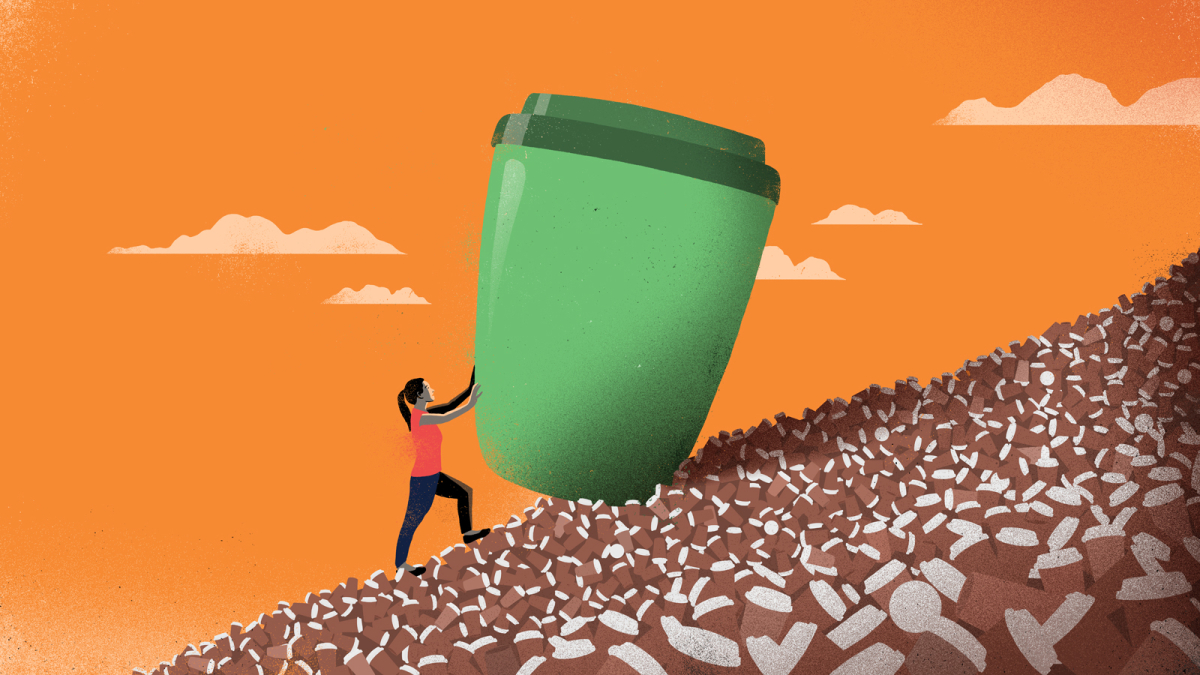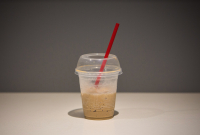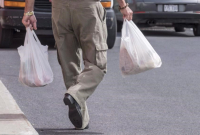Support strong Canadian climate journalism for 2025
This story is part of Covering Climate Now, a global collaboration of more than 220 news outlets to strengthen coverage of the climate story.
A funny thing happened when I tried to use my reusable coffee cup at McDonald’s.
“We can’t use that,” the cashier told me. A manager on duty explained it was for safety reasons — though the safety of whom, or what, was never made clear to me.
For the better part of the past two years, I’ve been a dedicated reusable-cup user. I’ve carted my cup with me almost everywhere. At the Starbucks closest to my old office, it became so recognizable the baristas would take it from me and start making my daily Americano before I even placed the order. I feel weird leaving the house without it, since there’s rarely a day I won’t crave at least one coffee.
The planet is dying, and like everyone else, I am very anxious about it. Using a reusable cup at least makes me feel as if I’m doing one small proactive thing to stop the Earth from heating up like an oven and cooking us all.
But am I really doing anything? As my McDonald’s misadventure proved, reusable cups haven’t been universally adopted — some stores won’t accept them and many people don’t use them despite encouragement. I wondered if there was any merit to the safety concerns.
And with more large chains investing in innovative new “green” cup designs, would I even need to worry about using a reusable cup in the future?
The answers have a few more wrinkles than I ever considered.
A 'greener' coffee cup
Waste generated by fast-food chains and coffee shops is a major issue. According to Zero Waste Canada, of the 14 billion cups of coffee consumed by very jittery Canadians every year, 35 per cent are served in single-use cups. Some municipalities have differing rules about what kinds of plastic can be recycled — in Toronto, for example, black plastic, which some coffee-cup lids are made of, are put in the trash. And the lining in coffee cups is difficult to separate from the cardboard.
So, we know we have a problem. The good news is there is growing recognition of that problem. Prime Minister Justin Trudeau has promised to ban harmful single-use plastics by 2021 and make corporations bear more of the cost for recycling plastic — assuming his Liberals win the upcoming federal election. If it does happen, the ban would come into effect at the same time as the European Union’s.
Fast-food companies have also begun to address their waste problem. I asked Starbucks, Tim Hortons and Second Cup whether their customers are allowed to use reusable containers. Not only are they allowed, they are actually encouraged. All three chains give discounts to customers who bring reusable cups, and some are going beyond that to reduce waste.
Starbucks stores “provide and fund in-store recycling in most stores and have items processed at a separate facility to ensure items that can be recycled are recycled, even in municipalities that currently do not support the processing of our current cups,” according to a spokesperson.
The chain will pilot a new “greener” cup in Vancouver this year, and has invested millions to fund development of a compostable cup. “We also introduced recyclable strawless lids and are working to eliminate plastic straws globally by 2020,” the spokesperson added.
At Second Cup locations in Quebec, the chain offers biodegradable straws and biodegradable cellulose fibre to wrap sandwiches.
And Tim Hortons has been showing off some of its green initiatives at its new Toronto innovation café, including strawless cold-cup lids, 100 per cent recyclable takeout packaging and a coffee cup made with 30 per cent post-consumer recycled material.
Tim Hortons is the first large quick-service restaurant in Canada to test a cup with 30 per cent recycled content, according to a spokesperson. The new Tim Hortons coffee-cup lids are, according to the company, recyclable and accepted in 95 per cent of curbside recycling programs across the country.
I sent the same query to all of Canada’s major airline carriers, as well as A&W and Recipe Unlimited — the operator of restaurant chains such as Harvey’s and Swiss Chalet. None of them responded.
I also asked McDonald’s for its policy. A brief scan of news items over the past six years showed most McDonald’s don’t seem to accept reusable mugs, but that might be changing.
“As part of our sustainability journey, we are currently assessing a new policy around reusable cups and will be testing procedures at our stand-alone McCafé locations in Toronto and our two Green Concept Restaurants in the near future,” a McDonald’s Canada spokesperson told me in an email. The two “Green Concept” restaurants in Vancouver and London, Ont., are also where McDonald’s tests new packaging and recycling options.
Tammara Soma is an assistant professor at Simon Fraser University and co-founder of Food Systems Lab, a research and innovation hub working on solutions for reducing food waste. When she and her family have a sit-down meal at A&W, she notes the entire meal — burgers, fries, pop — is served on dishware. “It's a fast-food chain,” she said. “Obviously, if A&W can do it... a lot of other fast-food chains can do it, too.”
She is more critical of the attempts at “green” packaging. “A lot of these biodegradable or compostable packagings are still problematic because they contaminate the bins — a lot of municipalities actually don't have the infrastructure to manage it,” she said. That’s because the cups and other packaging are lined with polymer that stops liquid from leaking but isn’t good for compost.
“The disposing part is not really addressing the root cause of the issue,” Soma added. “Even if they innovate into a product that is more biodegradable, it's still using resources... that take a lot of energy to produce and then to transport.”
A reusable cup may still be the best bet — but that comes with caveats.
One coffee, hold the biofilm
At this juncture of the story, I must admit a bad habit: I do not wash my reusable cup after every use. Sometimes, I don’t even wash it every day. It only has coffee in it, I figure, so I ask baristas to give it a rinse with hot water before refilling it.
I know this makes me a gross trash monster. And after talking to Keith Warriner, a professor in the department of food science at the University of Guelph, I feel a lot worse about it.
“When I think about reusable cups, it's one of those ones with lids some people carry around with them. The thing is, those lids can get what’s called biofilms — collections of bacteria. Most of those bacteria will probably be safe, but sometimes you can get pathogens on them. And so because you're sipping from it, obviously that's a direct sort of entry route,” he explained.
The other danger is presented by mould. “If you've left a coffee out for an amount of time, you notice a mould film and things like that form on the surface,” Warriner said. Those moulds could deposit mycotoxins, which, according to the World Health Organization, “can cause a variety of adverse health effects and pose a serious health threat to both humans and livestock.”
Technically, this shouldn’t be any restaurant’s problem. That I am disgusting and drinking coffee out of a potentially mould- and biofilm-laden cup is all my own doing. But, Warriner said, big corporate chains are often very concerned about limiting their legal liability. “What companies want is full control, right up to the point that they give you the product. Having reusable cups can overcome that,” he said.
But, on the balance, is the risk of getting sick from an improperly washed cup worse than filling the ocean with used coffee-cup lids? “Washing it out every day is good,” Warriner said. “That should prove safe.”
It also depends on what you put in the cup. Proteins like dairy are more likely to form biofilm. (He does note extra precaution has to be taken when using reusable containers to store higher-risk foods like deli meats, as much more serious infections can occur if food is improperly stored or the containers aren’t well-cleaned.)
I, for one, will be taking Warriner’s advice.
Ask how you can make a coffee cup
I bought my reusable cup online. It arrived from who knows where in a cardboard box, wrapped in plastic, in yet another cardboard box.
Some of the things we think help the planet may be less helpful than we hope. For example, according to a recent Vice story, you’d have to use a cotton tote for 11½ years to offset the amount of water pollution associated with the bag’s production.
An assessment done by the International Reference Centre for the Life Cycle of Products, Processes and Services found that for a reusable cup to offset the environmental effects of a single-use cup, it would need to be used for years, and minimally washed with soap and hot water, which, we just learned, is probably a pretty bad idea unless you are eager to ingest pathogens.
So do I just throw in the towel and accept that, no matter how hard I try, I am but a pebble in the tide of a sea scattered with plastic debris?
Not so, Soma said. It comes down to the three Rs — reduce, reuse, recycle — which most of us have been taught without any acknowledgement that they come in a specific order. “Focusing on the reuse part should be key, and not just on the recycling part,” she said.
Some have even made whole careers off showing how you can repurpose containers. Lauren Singer, better known on Instagram as Trash is for Tossers, has fit eight years of her garbage into one small mason jar. Anne-Marie Bonneau, the Zero-Waste Chef, shows people how to cook without using packaged or processed foods.
“When you're really thinking about reusable, a lot of it has to do with trying to look at what you already have and (using) it,” Soma said. “So in (Bonneau's) case, it's a lot of just using jars. And I realized, when I see people bringing their jars for coffee or bringing their jars for their lunch... it's really about this kind of lifestyle that's not about buying more to get to that zero-waste or that reduced-waste lifestyle.”
That said, this is not something entirely up to each individual. “I think there needs to be broader education or a harmonized policy to show what's possible, what's not possible,” she said.
But I also don’t completely discount individual actions. If we’re going to avert climate catastrophe, people should know that what they do — whether sailing across the Atlantic on a solar-powered boat, avoiding air travel, protesting or, yes, using reusable containers — matters. We just have to be smart about it.






Comments
Yes, not washing out your travel mug in between coffees is gross, especially if you add milk or cream. But I don't see how this endangers anyone other than the owner of the mug. Coffee is poured into mugs. I doubt that any of the mould or other contamination can climb up the stream. Our society has become too germ-phobic. We've got sanitizer dispensers at the entrance to almost every public building, but little discussion about why our immune systems are in such rough shape or how to nurse them back to health.
I'm not sure if you're aware of how reliant hospitals are on disposable everything, to combat that same pathogen issue. Or how much carbon they consume.
Bottom line, if your reusable causes one food-poisoning case for every 5,000 cups of coffee, it's probably an environmental negative. Not to mention the chance of dying.
Having a reusable coffee cup as far as I'm concerned is still the best way to contribute against climate change . All the ideas about using comfortable cups and or recyclable cups still demands a huge amount of resources such as trees (our beautiful forests) which absorb carbon. We need those forests to survive. It's obvious that people don't realize the harm we are causing with our convenient way of life .Even when sitting inside cafe;s the general population is using paper cups. The coffee chains are not encouraging the use of real cups it seems. !!
When I was working, I used a ceramic coffee mug from home. I'd rinse it from time to time, but it would go a long time between getting a proper cleaning in the dishwasher. Never had any ill effects. I also used a plastic water bottle, refilled with tap water. Now, of course, I make my own coffee/tea at home. What is concerning me these days is medical devices such as insulin pens, which are made more and more out of single-use plastic.
Regarding the McDonald's Issue ... I was actually quite furious when they refused to use my cup. I was travelling and needed a morning cupper.
It gave me yet another reason to never go there ...
I drink tea. No cream, no sugar ... and generally rinse it out with hot water myself - but only daily.
When I get a fill, I usually hang on to the lid and just hand the cup over. Because Germs are Gross. And I don`t want their hand germs on my mouthpiece ... so go figure, right?
Thanks for the added information! Will certainly share.
To answer the title's question: no, using a reusable cup is simply a distraction. We have to make significant and drastic lifestyle changes to have an impact on the crisis. That means disruptive changes in places we live, how and how much we travel, where we work, amongst other things. Coffee cups? - in the noise.
Exactly. In fact, the whole concept of fast food and coffee shops is likely to disappear in the near future, as they both require a fossil fuel infrastructure to exist (supply chain, industrial agriculture etc.) There are better ways to plan for a very scary future than to worry about coffee cups.
I agree — every little action helps, but people must not imagine that only recycling is going to help significantly. Driving to a coffee shop causes much more impact than what type of cup you use!